The Story of Arilbred Medians |
This article originally appeared in The Medianite,
2013-2014.
The Story of Arilbred
Medians
Modern arilbred dwarfs and arilbred medians have a dedicated following in the iris world. Growers whose climates do not favor the tall arilbreds often find more success with the smaller ones, which usually have dwarf bearded ancestry that makes them more adaptable to cooler, wetter conditions. For those who also grow the tall arilbreds, the arilbred dwarfs and medians add variety in size, season of bloom, and pattern and form. Arilbred medians have received the William Mohr medal more often than their tall arilbred competitors, and four have received the C. G. White medal.
Nevertheless, there is no officially sanctioned class or definition for these irises. Different terms have been used for them (and still are), and different people often use the same terms in different ways. In a companion article ("Coming to Terms with Arilbred Medians"), I discuss the problem of classifying the small arilbreds and explain the system used in my Checklist of Arilbred Dwarfs and Medians. The present article provides a look back at the history of the small arilbreds, which spans more than a century and involves many different hybridizers with varied breeding projects and goals.
The story of arilbred medians is closely intertwined with the story of arilbreds generally, and it is fair to say that both begin with the work of England's Sir Michael Foster. A tireless collector and student of iris species and their relationships, Foster made many of the first crosses between oncocyclus and Regelia species and the familiar bearded irises of the time. Although this work did not involve the dwarf bearded irises, the small size of many of the aril species and some of the diploid tall bearded irises he used often resulted in plants comparable to intermediates in general size and habit. The first to be introduced was 'Paracina' (1901), from Iris paradoxa X 'Sambucina'. Crossing I. paradoxa with I. pallida produced 'Hamadan' (1909) and 'Lady Lilford' (1916), while I. pallida paired with I. iberica produced 'Giran' (1913) and 'Nazarin' (1913). Years later, when the American Iris Society compiled their early checklists, these irises would be classified as "intermediate miscellaneous bearded" (IMB), recognizing their intermediate size and mixed aril/bearded parentage.
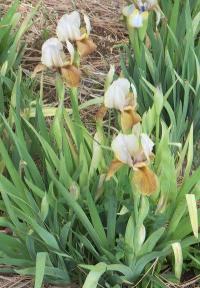 The
first arilbred to be introduced into commerce with a dwarf bearded
parent was 'Zwanenburg' from Louis Denis of France, in 1912. Unlike
the Foster creations, this is still available in commerce and grown
in gardens today. A strange gray-gold blend, it is the size of an
SDB. Its parentage is given as 'Lutescens Aurea' x I. susiana.
'Lutescens Aurea' is a dwarf bearded cultivar of the I.
lutescens group. 'Zwanenburg' has some fertility as a pollen
parent, having produced seven registered offspring.
The
first arilbred to be introduced into commerce with a dwarf bearded
parent was 'Zwanenburg' from Louis Denis of France, in 1912. Unlike
the Foster creations, this is still available in commerce and grown
in gardens today. A strange gray-gold blend, it is the size of an
SDB. Its parentage is given as 'Lutescens Aurea' x I. susiana.
'Lutescens Aurea' is a dwarf bearded cultivar of the I.
lutescens group. 'Zwanenburg' has some fertility as a pollen
parent, having produced seven registered offspring.
In 1955 (in translation, ASI Yearbook 1966), Marc Simonet reported a chromosome count of 42, and suggested that the stated parentage was in error, and that the pollen parent was 'Ib-Mac', which Denis grew and used extensively. This would make it an unbalanced tetraploid, ¼ aril. Simonet also cited the general resemblance of 'Zwanenburg' to other arilbreds from I. lutescens x 'Ib-Mac'.
In the 1978 ASI Yearbook, however, Randolph and Mitra reported counting 'Zwanenburg' as 2n=40. Their interpretation was that the published parentage is correct, and that I. susiana contributed an unreduced gamete, making 'Zwanenburg' ½ aril. Interestingly, Sidney Mitchell stated that he believed the correct parentage is I. susiana X 'Statellae' (also a dwarf of the I. lutescens type). This adds plausibility to the unreduced gamete interpretation. In any case, 'Zwanenburg' remains an iris of unique historical and genetic interest, as well as a garden conversation piece.
In the following decades, adventurous breeders who managed to grow both arils and dwarfs would sometimes cross them. The types of irises avaible in the first half of the twentieth century were very different from what we grow now. The only reliably fertile arilbred was 'Ib-Mac', seldom grown and used. The standard dwarfs as we know them did not exist. Virtually all the dwarf bearded irises were forms of I. lutescens (known at the time as I. chamaeiris), a species from southern Europe with flowers in purple or light yellow. Williamson and Gersdorff used a dwarf of this sort with I. korolkowii to produce 'Baby Blue' and 'Fallen Leaf', introduced in 1931. 'Fallen Leaf' was still being grown in the 1980s, although I doubt it can be found at present.
The pioneering American breeders Hans and Jacob Sass of Nebraska made similar crosses, using the Van Tubergen regeliocyclus 'Beatrix' to produce 'Balroudour', 'Blue Topaz', 'Gray Cloud', 'Stormy Dawn' and 'Velvo', all introduced in 1933. Later, they used the Regelia species I. stolonifera and I. hoogiana to produce 'Spotless' (1938), 'Blue Princess', 'Mountain Pottery', 'New Era', and 'Party Robe' (all 1946) and finally 'Spring Caper' (1949).
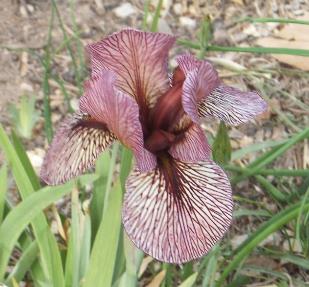 When
C. G. White of California began introducing arilbreds in the 1930s,
he was using both diploid and tetraploid tall bearded varieties and a
range of aril species and hybrids. Many of the resulting arilbreds,
like those of Sir Michael Foster, were of roughly intermediate size.
Although some of these, like 'Oyez', are still popular and widely
grown, most have now gone by the wayside. With specific height
measurements not being recorded in the 1930s and 1940, we have little
to go on but the "IMB" classification code to judge which of these
plants might be regarded as median-sized if they were produced today.
In any case, White was certainly not trying to produce small
arilbreds.
When
C. G. White of California began introducing arilbreds in the 1930s,
he was using both diploid and tetraploid tall bearded varieties and a
range of aril species and hybrids. Many of the resulting arilbreds,
like those of Sir Michael Foster, were of roughly intermediate size.
Although some of these, like 'Oyez', are still popular and widely
grown, most have now gone by the wayside. With specific height
measurements not being recorded in the 1930s and 1940, we have little
to go on but the "IMB" classification code to judge which of these
plants might be regarded as median-sized if they were produced today.
In any case, White was certainly not trying to produce small
arilbreds.
An interesting sidebar to breeding in this era was the use of the psammiris species I. humilis (then known as I. arenaria and I. flavissima) and I. bloudowii. These species have a tiny aril on their seeds, and for a time (under the Lawrence classification endorsed by the American Iris Society in the 1950s, 1960s, and 1970s) were grouped together with the Regelias and treated as arils. They were not regarded as such by the dwarf breeders of the 1930s and 1940s, who found them desirable for their bright yellow color and flaring falls, traits uncommon in the I. lutescens dwarfs of the time. A number of hybrids were produced by crossing I. humilis with garden dwarfs, beginning with Grace Sturtevant's 'Ylo' (1926), but not taking off until later with Paul Cook's 'Keepsake' and 'Tampa' (1935), and later 'Promise' (1952), which received the Caparne award in 1966. In 1943, Hillson introduced 'Bronya', 'Cream Tart', 'Mist o' Pink', and 'Tiny Treasure'. Walter Welch introduced 'Cup and Saucer' (1951), 'Bricky' (1956), 'Morning Light' (1956), and 'Glow Gleam' (1958). Ed Zickler produced the popular 'Butterball' (1953) and 'Buster Brown' (1954). Although interest in using I. humilis declined after the modern SDBs appeared on the scene, these irises have a distinctive look and a few are still being grown.
I. pumila became available to US breeders in the 1940s. Paul cook crossed it with I. hoogiana to produce the fertile, ½ aril arilbred dwarfs 'Hoogpum Blue' and 'Hoogpum Purple' (1956). The same year, Jay Ackerman introduced the pumila/humilis hybrids 'Pumar Alpha' and 'Pumar Beta'.
The 1950s were a decade of great change in the iris world. C. G. White had produced a family of fertile arilbreds, beginning with Joppa Parrot in 1945, and with a stream of new ones through the 1950s. These had a wide range of color and pattern and gave rise to a whole new direction in arilbred breeding, which previously had been dominated by the ¼-aril "Mohrs", mostly produced by crossing 'Capitola' with TBs. Of even farther-reaching consequence was the creation of the modern standard dwarfs (then called "lilliputs") from crossing TBs with I. pumila. Unlike the old "chamaeiris" dwarfs, these new medians showed a startling range of bright colors and patterns, and more modern form from their tall bearded parents. It was only a matter of time until breeders crossed the new arilbreds with the new SDBs.
The first vanguard of what these developments would mean for the arilbred medians was Wilma Vallette's 'Water Nixie' (1958) and 'Lillimohr' (1959) from 'Baria' x 'Capitola', and 'Border Queen' (1959) from 'Green Spot' x 'Capitola'. These were diminutive versions of the popular "Mohr type" arilbreds, of roughly IB size and showing the rounded form and unusual color patterning from their oncocyclus ancestry.
The crossing of a standard dwarf with a fertile C. G. White type arilbred ("SDB x CGW") would become the classic cross for arilbred medians, as SDB x TB is for intermediates. 130 small arilbreds from such breeding have been registered as of this writing. They average about 16 inches in height, although a few are much smaller or much taller. Being ¼ aril, they generally have less of an "aril look" than their arilbred parents, but are often easier to grow in a wide range of climates. Unlike the irises described earlier, these new arilbred medians seemed to constitue a clear "type" that gardeners came to recognize and appreciate.
The two most prominent hybridizers at the beginning of this new type of breeding were Stanley Street and Doris Foster. Street's arilbred medians 'Saletta' (1963) and 'Girl Watcher' (1967) both received the William Mohr award. Foster received the award four times, for 'Fairy Goblin' (1967), 'Mint Parfait' (1967), 'Stitchery' (1971), and 'Little Orchid Annie' (1973).
It wasn't long before more breeders got involved in this type of cross. Hooker Nichols of Oklahoma received the Mohr award twice, for 'Byzantine Beauty' (1977) and 'Cairo Love Song' (1980). A later introduction, 'Solomon's Glory' (1985), won the Mohr medal in 1996.
 A
second type of small arilbred made a dramatic entrance in 1966, when
Melrose Gardens introduced the "Kelita" series from Jonnye Rich
('Kelita Adah', 'Kelita Helbah', 'Kelita Ithra', 'Kelita Jaroah',
'Kelita Jethro', 'Kelita Jezebel', and 'Kelita Zipporah'.) These were
produced from crossing a pure oncocyclus seedling of Lloyd Austin's
with 'Pogo', an SDB. They consequently had a higher oncocyclus
content than the SDB x CGW arilbred medians, and were also much
smaller in stature, averaging around 10 inches in height. Although
none of the "Kelitas" won top awards, they attracted attention and
helped reinforce the idea that the small arilbreds really constituted
a new category of iris (Melrose used the term "arilmed" for them).
Although they are less easy to produce than the SDB x CGW types (few
people grow the pure arils needed), there has been a slow steady
stream of them introduced over the years, 29 as of this writing.
'Loudmouth' (Rich, 1970) from 'Bagdad Beauty' x 'Knotty Pine',
received the C. G. White award in 1972, and remains a popular garden
iris for its vigor and distinctiveness.
A
second type of small arilbred made a dramatic entrance in 1966, when
Melrose Gardens introduced the "Kelita" series from Jonnye Rich
('Kelita Adah', 'Kelita Helbah', 'Kelita Ithra', 'Kelita Jaroah',
'Kelita Jethro', 'Kelita Jezebel', and 'Kelita Zipporah'.) These were
produced from crossing a pure oncocyclus seedling of Lloyd Austin's
with 'Pogo', an SDB. They consequently had a higher oncocyclus
content than the SDB x CGW arilbred medians, and were also much
smaller in stature, averaging around 10 inches in height. Although
none of the "Kelitas" won top awards, they attracted attention and
helped reinforce the idea that the small arilbreds really constituted
a new category of iris (Melrose used the term "arilmed" for them).
Although they are less easy to produce than the SDB x CGW types (few
people grow the pure arils needed), there has been a slow steady
stream of them introduced over the years, 29 as of this writing.
'Loudmouth' (Rich, 1970) from 'Bagdad Beauty' x 'Knotty Pine',
received the C. G. White award in 1972, and remains a popular garden
iris for its vigor and distinctiveness.
Neither of these two types of small arilbred shows any significant fertility. The only way to produce more of them is to repeat the type of wide cross that produces them.
The 1980s and 1990s saw continued improvements in both types of small arilbreds developed in the decades before. As SDBs became wider and more ruffled, and arilbreds appeared with larger signals and more dramatic patterns, the arilbred medians became correspondingly showier. The prominent breeders of this era were Fred Gadd and Carl Boswell. Gadd received the Mohr award for 'Sizzle' (1978) and Mohr medals for 'Bozrah' (1990) and 'Patriot's Gem' (1993).
Boswell holds the record for the number of Mohr awards and medals received (nine altogether), cleverly managing to have 'Smoke with Wine' (1981), 'Jewel of Omar' (1986), and 'Omar's Torch' (1986) win twice, first as Mohr award winners (equivalent to Award of Merit), and then subsequently as Mohr medal winners, after the medal had been created as an award above the AM. His other winners are 'Green Eyed Sheba' (1984), and 'Omar the Tentmaker' (1989). It is worthy of note than none of Boswell's Mohr winners comes from the conventional SDB x CGW breeding, but rather from various mixes of arilbreds, SDBs, pure arils, and bearded species.
Boswell received two C. G. White medals, for 'Omar's Eye' (1995) and 'Omar's Stitchery' (2000), siblings from an SDB-type dwarf x aril hybrid cross.
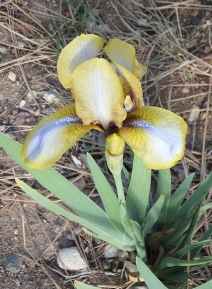
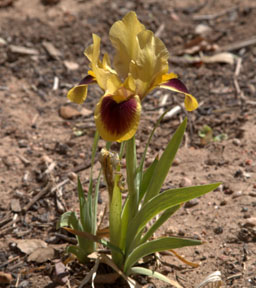
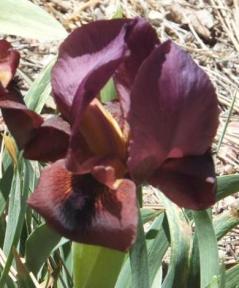
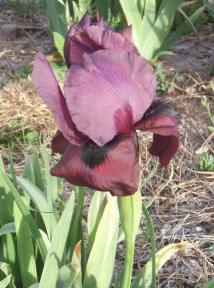
This time period also saw increased work on small arilbreds that are truly ½ aril, with two sets of aril chromosomes. French hybridizer Lawrence Ransom's "Vera girls" ('Vera-Anne', 'Vera-Beatrice', 'Vera-Louise', 'Vera-Marina', 'Vera-Olivia', and 'Vera-Ruby', all introduced in 1996) were produced by crossing the tetraploid regeliocyclus 'Vera' with SDBs. Although ½ aril, these are infertile, since the SDB parent contributes two unlike sets of chromosomes that do not readily pair.
More promising from the breeder's standpoint were the nascent emergence of two fertile families of amphidiploid arilbred dwarfs and medians. Arilbred dwarfs from crossing tetraploid arils with I. pumila were produced by Harald Mathes in Germany ('Barbarella', 1992) and Francesca Thoolen in California ('Aladdin's Gem', 2002). Both are diminutive, show strong aril features, and are fertile pollen parents. Mathes's 'Anacrusis' line began with an oncogelia seedling crossed with I. suaveolens and subsequently converted to tetraploidy. The seedling, as expected, was fertile with C. G. White type arilbreds; crossing with 'Dresden Gold' produced 'Anacrusis', a 20-inch-tall halfbred, half of whose beared ancestry comes from the tiny dwarf species I. suaveolens. Continued breeding in this line eventually produced 'Concerto Grosso' (1998), which received the C. G. White medal in 2005.
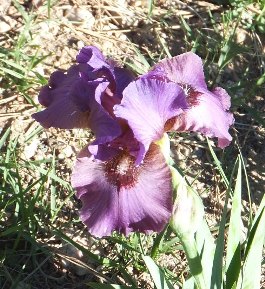 The
classic arilbred medians from SDB x CGW crosses continue to improve
in both form and variety of color and pattern. Some now show aril
traits much more strongly than did their antecedents of decades past.
Recent Mohr medal winners include George Sutton's 'Shabaza' (2008)
and 'Ulalena' (2010), 'She Devil' (Black, 1996), 'Persian Sapphire'
(Baumunk, 2005, from 'Chubby Cheeks' x 'Barbarella'), and 'Suspect'
(Johnson, 2006). Along with Sutton, Black and Johnson of Mid-America
Gardens in Oregon are the most prominent arilbred median hybridizers
at present, producing new varieties each year. Lawrence Ransom and
Elm Jensen also both maintain an active interest in hybridizing
arilbred medians.
The
classic arilbred medians from SDB x CGW crosses continue to improve
in both form and variety of color and pattern. Some now show aril
traits much more strongly than did their antecedents of decades past.
Recent Mohr medal winners include George Sutton's 'Shabaza' (2008)
and 'Ulalena' (2010), 'She Devil' (Black, 1996), 'Persian Sapphire'
(Baumunk, 2005, from 'Chubby Cheeks' x 'Barbarella'), and 'Suspect'
(Johnson, 2006). Along with Sutton, Black and Johnson of Mid-America
Gardens in Oregon are the most prominent arilbred median hybridizers
at present, producing new varieties each year. Lawrence Ransom and
Elm Jensen also both maintain an active interest in hybridizing
arilbred medians.
The SDB x CGW type of arilbred median will continue to be important in the future, as the two parental types continue to improve and become more varied. We also have the beginnings of two fertile families in the small arilbreds, waiting to be developed to their full potential.
These small arilbreds fill an important niche in the garden, and have many admirers. From their beginnings in experimental crosses made in the early 1900s (probably most often for reasons of simple curiosity), they have emerged as a class of iris with a distinct identity. Most combine tall bearded, dwarf bearded, Regelia, and oncocyclus ancestry in a single plant, a true melting pot of this branch of the genus. Every iris garden needs at least a few!
The sequel to this article, explaining the proposed terminology for the smaller arilbreds, is Coming to Terms with Arilbred Medians.
Photos: 'Zwanenburg', 'Oyez', 'Loudmouth', 'Vera-Marina', 'Aladdin's Gem', 'Anacrusis', 'Concerto Grosso', and 'Suspect'.
February 2014
Updated April 2018
|
|
Unless otherwise noted, all text and illustrations copyright Tom Waters and all photographs copyright Tom or Karen Waters. Please do not reproduce without permission.